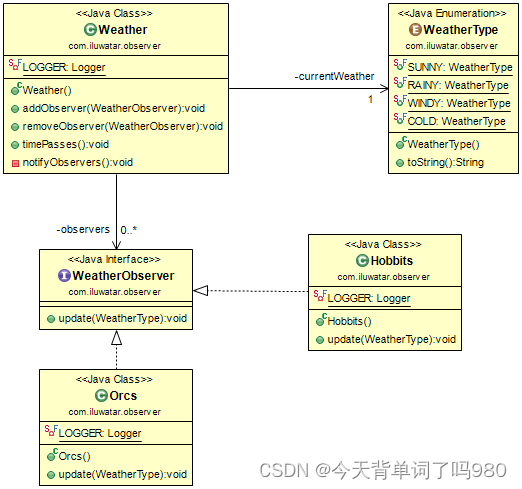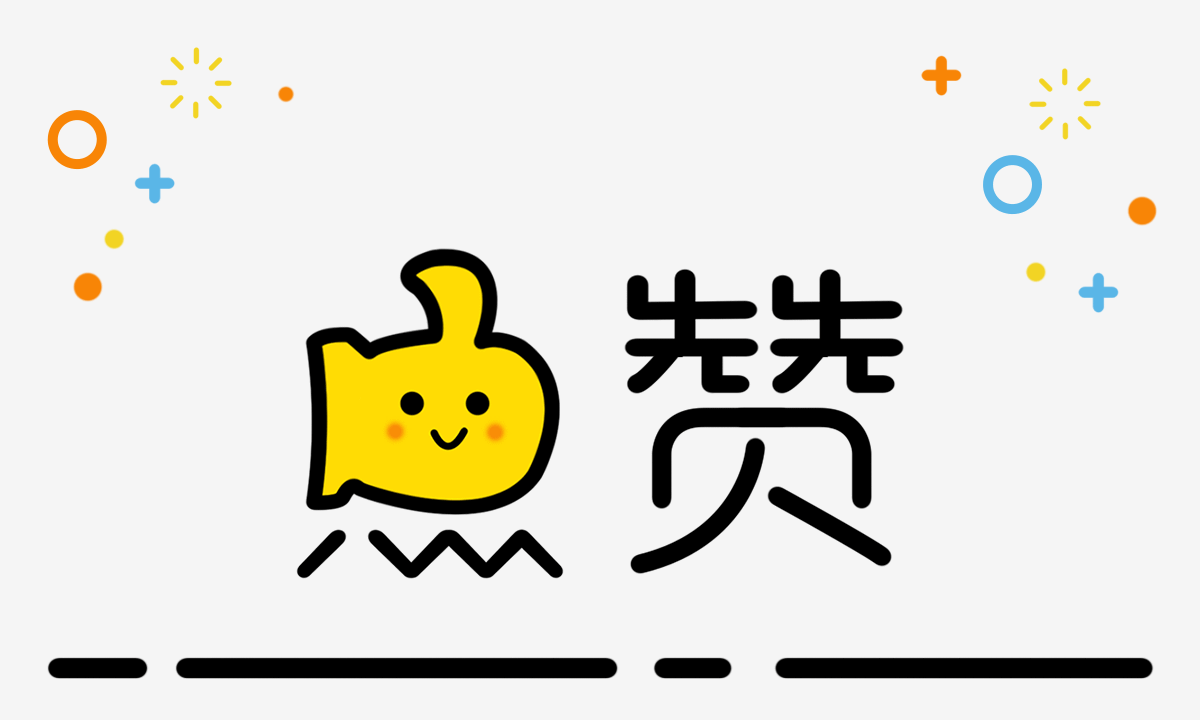🔍目的
定义一种一对多的对象依赖关系这样当一个对象改变状态时,所有依赖它的对象都将自动通知或更新。
🔍解释
真实世界例子
在遥远的土地上生活着霍比特人和兽人的种族。他们都是户外生活的人所以他们密切关注天气的变化。可以说他们不断地关注着天气。
通俗描述
注册成为一个观察者以接收对象状态的改变。
维基百科
观察者模式是这样的一种软件设计模式:它有一个被称为主题的对象,维护着一个所有依赖于它的依赖者清单,也就是观察者清单,当主题的状态发生改变时,主题通常会调用观察者的方法来自动通知观察者们。
编程示例
首先创建天气观察者的接口以及我们的种族,兽人和霍比特人。
java
public interface WeatherObserver {
void update(WeatherType currentWeather);
}
@Slf4j
public class Orcs implements WeatherObserver {
@Override
public void update(WeatherType currentWeather) {
LOGGER.info("The orcs are facing " + currentWeather.getDescription() + " weather now");
}
}
@Slf4j
public class Hobbits implements WeatherObserver {
@Override
public void update(WeatherType currentWeather) {
switch (currentWeather) {
LOGGER.info("The hobbits are facing " + currentWeather.getDescription() + " weather now");
}
}创建一个动态变化的天气:
java
@Slf4j
public class Weather {
private WeatherType currentWeather;
private final List<WeatherObserver> observers;
public Weather() {
observers = new ArrayList<>();
currentWeather = WeatherType.SUNNY;
}
public void addObserver(WeatherObserver obs) {
observers.add(obs);
}
public void removeObserver(WeatherObserver obs) {
observers.remove(obs);
}
/**
* Makes time pass for weather.
*/
public void timePasses() {
var enumValues = WeatherType.values();
currentWeather = enumValues[(currentWeather.ordinal() + 1) % enumValues.length];
LOGGER.info("The weather changed to {}.", currentWeather);
notifyObservers();
}
private void notifyObservers() {
for (var obs : observers) {
obs.update(currentWeather);
}
}
}执行示例:
java
var weather = new Weather();
weather.addObserver(new Orcs());
weather.addObserver(new Hobbits());
weather.timePasses();
// The weather changed to rainy.
// The orcs are facing rainy weather now
// The hobbits are facing rainy weather now
weather.timePasses();
// The weather changed to windy.
// The orcs are facing windy weather now
// The hobbits are facing windy weather now
weather.timePasses();
// The weather changed to cold.
// The orcs are facing cold weather now
// The hobbits are facing cold weather now
weather.timePasses();
// The weather changed to sunny.
// The orcs are facing sunny weather now
// The hobbits are facing sunny weather now🔍类图

🔍扩展延伸
观察者模式在kafka client consumer中的使用:
大致逻辑:
consumer想要消费kafka broker中的数据需要发送request,request发送的结果用RequestFuture来表示,RequestFuture中包含RequestFutureListener,当request处理完成后RequestFutureListener的相关方法会被调用。RequestFutureCompletionHandler用来处理RequestFuture、ClientResponse还有RuntimeException。
依赖关系:
RequestFutureListener为观察者,onSuccess和onFail方法相当于之前的update方法;RequestFuture为被观察者,addListener相当于attach方法,fireSuccess和fireFailure方法相当于notify方法。
RequestFutureListener部分代码:
java
public interface RequestFutureListener<T> {
void onSuccess(T value);
void onFailure(RuntimeException e);
}RequestFuture部分代码:
java
public class RequestFuture<T> implements ConsumerNetworkClient.PollCondition {
private static final Object INCOMPLETE_SENTINEL = new Object();
private final AtomicReference<Object> result = new AtomicReference<>(INCOMPLETE_SENTINEL);
private final ConcurrentLinkedQueue<RequestFutureListener<T>> listeners = new ConcurrentLinkedQueue<>();
private final CountDownLatch completedLatch = new CountDownLatch(1);
public void complete(T value) {
try {
if (value instanceof RuntimeException)
throw new IllegalArgumentException("The argument to complete can not be an instance of RuntimeException");
if (!result.compareAndSet(INCOMPLETE_SENTINEL, value))
throw new IllegalStateException("Invalid attempt to complete a request future which is already complete");
fireSuccess();
} finally {
completedLatch.countDown();
}
}
//遍历listener并调用其success时的方法
private void fireSuccess() {
T value = value();
while (true) {
RequestFutureListener<T> listener = listeners.poll();
if (listener == null)
break;
listener.onSuccess(value);
}
}
//遍历listener并调用其fail时的方法
private void fireFailure() {
RuntimeException exception = exception();
while (true) {
RequestFutureListener<T> listener = listeners.poll();
if (listener == null)
break;
listener.onFailure(exception);
}
}
//增加listener
public void addListener(RequestFutureListener<T> listener) {
this.listeners.add(listener);
if (failed())
fireFailure();
else if (succeeded())
fireSuccess();
}🔍适用场景
在下面任何一种情况下都可以使用观察者模式
- 当抽象具有两个方面时,一个方面依赖于另一个方面。将这些方面封装在单独的对象中,可以使你分别进行更改和重用
- 当一个对象的改变的同时需要改变其他对象,同时你又不知道有多少对象需要改变时
- 当一个对象可以通知其他对象而无需假设这些对象是谁时。换句话说,你不想让这些对象紧耦合。
🔍Ending
观察者模式(Observer Pattern)是一种行为设计模式,它定义了一种一对多的依赖关系,使得当一个对象的状态发生变化时,所有依赖于它的对象都会得到通知并自动更新。
在观察者模式中,通常包含以下几个角色:
- 主题(Subject):被观察的对象,它会维护一组观察者对象,并在自身状态发生变化时通知观察者。
- 观察者(Observer):观察主题对象的状态变化,并根据变化做出相应的动作。
- 具体主题(ConcreteSubject):实现了主题接口的具体对象,负责维护观察者列表,并在自身状态发生变化时通知观察者。
- 具体观察者(ConcreteObserver):实现了观察者接口的具体对象,负责接收主题对象的通知,并根据通知更新自身状态。
希望本文能够帮助读者更深入地理解观察者模式,并在实际项目中发挥其优势。谢谢阅读!
希望这份博客草稿能够帮助到你。如果有其他需要修改或添加的地方,请随时告诉我。
